- Home
- Hunter S. Thompson
Fear and Loathing in America Page 3
Fear and Loathing in America Read online
Page 3
In the pages that follow are largely unedited letters documenting eight years in the high-speed life and times of Hunter S. Thompson. As in The Proud Highway, the dilemma was choosing which letters to include, which to excise. At a party to celebrate the twenty-fifth anniversary of the publication of Fear and Loathing in Las Vegas, a reporter from Entertainment Weekly asked Jann Wenner what Thompson would have been without drugs and guns. “An accountant,” Wenner answered without hesitation. “No doubt about it.” When asked about this, Thompson replied: “Well, Jann says a lot of stupid things. He used to be smart, but now he’s just another bean-counter.”
For every letter included in this volume, five others were cut. Some of the axed missives were of an intense personal nature regarding Thompson’s wife, Sandy, and son, Juan. Others were rejected because of repetition or their financial nature. Many of the letters dealing with Aspen politics were left out due to their obsolete “inside baseball” content. An effort was made, however, to include letters that showcase Thompson’s struggles as an aspiring writer, the difficult task he confronted waking up every day with a sheet of snow-white paper in his typewriter, seemingly demanding that first-rate prose come to grace it.
At times Thompson’s uncompromising perfectionism overwhelmed his editors. But it must be remembered that he was a self-made, rugged individualist living in the wilds of Colorado, thousands of miles from Madison Avenue. Worried that treacherous New Yorkers were going to take advantage of his high-country isolation and rip him off, Thompson assiduously stayed on top of his business affairs, threatening lawsuits over late checks and sloppy bookkeeping. There is a legalistic quality to many of these letters, with Thompson playing the righteous Clarence Darrow dueling fraudulent and churlish confidence men of every stripe. Over the years, in fact, Thompson has worked on a book he calls “Hey Rube,” a wicked manifesto that lampoons the white-collar criminals and New Age astrologers who take advantage of the hardworking, honest folks in the provinces that John Steinbeck wrote about with such tender awareness. Filled with an avenger’s rhetoric and idiopathic outrage, “Hey Rube” is Thompson’s all-seasons scorecard against the world of fast-talking money manipulators, used-car salesmen, and TV evangelists.
Behind the complex personality of Hunter S. Thompson—the Gonzo journalist cranked up on Chivas Regal, Dunhill cigarettes, and LSD—lurks a trenchant humorist with a sharp moral sensibility. For Thompson understands that against the assault of laughter nothing can stand, at least not for long. His exaggerated style may defy easy categorization, but his career-long autopsy on the death of the American Dream places him among the twentieth century’s most iconoclastic writers. Outsized truths are Thompson’s stock-in-trade, and the comic savagery of his best work will continue to electrify readers for generations to come. Perhaps novelist Tom Robbins comes closest to explaining the enduring high-octane appeal of Thompson’s work: “His prose style reads like he’s careening down a mountain highway at 110 miles an hour, steering with his knees.”
It would be a mistake to claim that Fear and Loathing in America answers the question of whether Thompson writes fiction or nonfiction. But we do learn what a literary workhorse he was during the chaotic era of Woodstock and Watergate. Like Mark Twain, he believed that the difference between the nearly right word and the right word was a large matter, the difference between the lightning bug and the lightning. An aspiring Gonzo journalist working for some alternative newspaper like the Boulder Planet or an Associated Press stringer anxious to insert invective into his copy would be wise to take note of the supreme discipline Thompson devoted toward perfecting every word in every line. As with Hemingway, many young writers ache to imitate Thompson’s hyperbolic style and maverick attitude; they nearly all fail miserably. There is only one Hunter S. Thompson: an incorrigible, doom-haunted observer whose dazzling prose and outlaw persona have made a distinctive mark on our times.
Douglas Brinkley
New Orleans
July 15, 2000
* Special thanks to Shelby Sadler for researching/writing the footnotes and many of the letter introductions and contributing editorially to the entire volume; Marysue Rucci for brilliantly overseeing the entire Simon & Schuster editorial process; Deborah Fuller for managing the Thompson Archive in Woody Creek, Colorado; Erica Whittington of the Eisenhower Center at the University of New Orleans for manuscript preparation and superb editorial assistance; Anita Bejmuk for her heroic all-night proofreading sessions; Curtis Robinson for brainstorming with Dr. Thompson and creating subheads; and Wayne Ewing for his ceaseless intellectual input into how to improve Fear and Loathing in America.
Author’s Note by Hunter S. Thompson
The Form calls for me to write a few words of wisdom at this point—but I am not feeling wise tonight, so I will leave that job to Mr. Halberstam, who is better at it than I am.
These letters are not the work of a wise man, but only a player and a scribe with a dangerous gambling habit. … That is a risky mix that will sooner or later lead you to cross the wrong wires and get shocked, or even burned to a cinder. On some days you will be lucky and only break your fingers and make a fool of yourself. But luck is a very thin wire between survival and disaster, and not many people can keep their balance on it.
I have never believed much in luck, and my sense of humor has tended to walk on the dark side. Muhammad Ali, one of my very few heroes, once took the time to explain to me that “there are no jokes. The truth is the funniest joke of all.”
Ho ho. It takes a special kind of mind-set to believe that & still have smart people call you Funny. I have never quite understood it.
But there are many things that I have never quite understood—and these letters, to me, are a sort of berserk historical record of my efforts to grope & flail & occasionally crawl along in the darkness and try to make functional sense of it. That is the best we can do, I think, and Luck has little to do with it. The real keys are timing, and balance, and the learned ability to know a hot wire when you see one.
People who count on luck don’t last long in the business of defusing bombs and disarming land mines, and that is what my business seems to be. It helps to know these things. Muhammad Ali was not lucky. He was fast, very fast.
The period covered in these letters (1968–1976) was like riding on top of a bullet train for eight years with no sleep and no wires to hang on to. (Is that a dangling participle?) Never end a sentence with a preposition. Never get off a train while it’s moving. These are only a few of the rules I have learned & carefully broken in my time.
“Beer on whiskey, mighty risky—Whiskey on beer, never fear.” That is a rule I learned early, and it has always served me well. I don’t take credit for it, but I will pass it along as truth. It has stood the test of experience.
So that’s about it for my wisdom tonight. (I guess I lied. Or maybe I just changed my mind. So what?) Right now I am focused on going out in my dark front yard and shooting a bear who weighs five hundred pounds and is into a feeding frenzy…. I don’t want to kill the bear, I just want to sting it in the ass & make it move along. I am a territorial man, and I have been here longer than the bear has.
I don’t mind sharing with him, in principle—but the bear is rude, and he makes a mess when he eats. I have plenty of food, and if the bear wants to act right, I will feed him. If he has interesting things to say, I will offer him whiskey & shrimp & snow-peas. I am a good listener. But I don’t have time for guests who compel me to keep a loaded .44 Magnum on my side of the table because they might go wild & get into a feeding frenzy.
If that happens, I will quickly shoot the beast, but that would bring its own strange problems, and I don’t need them.
And so much for that, eh? Fuck bears. I will deal with them soon enough. … Right now we are talking about Letters, many letters, and my job is to find some meaning in them, which is not an easy assignment.
All I can see, for sure, is that I got what they call an “adult dose” of American political
reality in an era when the nation seemed to be going up in flames every day of every week. There was no relief from it, and no place to hide. You didn’t have to be a “revolutionary” to be part of the Revolution—and even if you were innocent, you could be beaten & gassed just for watching. In a four-year span I was tear-gassed or beaten or chased like a rat by police about two hundred times in at least twenty states, from Key Biscayne to the Olympic Peninsula, from Gainesville & Miami to Montreal & Austin & the gates of Beverly Hills. I had such a steady diet of riot-control gas that I became a junkie, & I still get nostalgic for it on slow nights.
I came to know gunfire and panic and the sight of my own blood on the streets. I knew every airport in the country before they had metal-detectors & you could still smoke on planes. Pilots knew me by name and stewardesses took me home when my flights were grounded by snow. I made many new friends & many powerful enemies from coast to coast. I went without sleep for seventy or eighty hours at a time & often wrote five thousand words in one sitting. It was a brutal life, and I loved it.
My main luxury in those years—a necessary luxury, in fact—was the ability to work in and out of my home-base fortress in Woody Creek. It was a very important psychic anchor for me, a crucial grounding point where I always knew I had love, friends, & good neighbors. It was like my personal Lighthouse that I could see from anywhere in the world—no matter where I was, or how weird & crazy & dangerous it got, everything would be okay if I could just make it home. When I made that hairpin turn up the hill onto Woody Creek Road, I knew I was safe.
Or at least I was safe from my enemies. Nobody is safe from their friends, and especially not me. I have never really worried about my enemies—not even when they included the president, the director of the FBI, or the district attorneys in five states. …I am generally proud of my enemies. The list is long & I still hate every one of them. I have forgiven a lot of the minor sins, but the major ones will still get me cranked up in a matter of seconds, on a hot rainy day in the wrong town.
Jesus. This riff could go on & on, so let’s leave it for now—except to add, in boldface, thanks to Sandy Thompson and Juan Thompson, who had to Live with the whole bizarre saga and kept the home fires burning at all times. … You bet, we need those fires, bubba, and we need that place to laugh. So, thanks again. And may the right gods fall in love with you, like I did.
Hunter S. Thompson
Woody Creek, Colorado
August 20, 2000
1968
CHICAGO: THE GREAT AMERICAN SLAUGHTER-HOUSE … PUBLIC MURDERS & PRIVATE BEATINGS … WHIPPED LIKE A DOG WITH THE WHOLE WORLD WATCHING … WHICH SIDE ARE YOU ON? … CLANDESTINE MEETING WITH NIXON, COUP DE GRCE FOR THE SIXTIES …
Thompson’s press pass for the 1968 Democratic National Convention in Chicago.
(COURTESY OF HST ARCHIVES)
Self-portrait, Woody Creek, 1968.
(PHOTO COURTESY OF HST ARCHIVES)
Juan Thompson, age four, views a bullet-riddled portrait of FBI director J. Edgar Hoover, summer 1968.
(PHOTO COURTESY OF HST ARCHIVES)
The Gamekeeper, summer 1968.
(PHOTO BY BURK UZZLE)
OWL FARM—WINTER OF ’68:
1967 was the year of the hippy. As this is the last meditation I intend to write on that subject, I decided, while composing it, to have the proper background. So, in the same small room with me and my typewriter, I have two huge speakers and a 100 watt music amplifier booming out Bob Dylan’s “Mr. Tambourine Man.” This, to me, is the Hippy National Anthem. It’s an acid or LSD song—and like much of the hippy music, its lyrics don’t make much sense to anyone not “cool” or “with it” or “into the drug scene.” I was living in San Francisco’s Haight-Ashbury district when the word “hippy” was coined by San Francisco Chronicle columnist Herb Caen—who also came up with “beatnik,” in the late 1950s—so I figure I’m entitled to lean on personal experience in these things. To anyone who was part of that (post-beat) scene before the word “hippy” became a national publicity landmark (in 1966 and 1967), “Mr. Tambourine Man” is both an epitaph and a swan-song for the lifestyle and the instincts that led, eventually, to the hugely-advertised “hippy phenomenon.”
Bob Dylan was the original hippy, and anyone curious about the style and tone of the “younger generation’s” thinking in the early 1960s has only to play his albums in chronological order. They move from folk-whimsy to weird humor to harsh social protest during the time of the civil rights marches and the Mississippi summer protests of 1963 and ’64. Then, in the months after the death of President Kennedy, Dylan switched from the hard commitments of social realism to the more abstract “realities” of neo-protest and disengagement. His style became one of eloquent despair and personal anarchism. His lyrics became increasingly drug-oriented, with double-entendres and dual meanings that were more and more obvious, until his “Rainy Day Women #12 & 35” was banned by radio stations from coast to coast … mainly because of the chorus line saying “Everybody must get stoned. …”
By this time he was a folk hero to the “under thirty generation” that seemed to be in total revolt against everything their elders were trying to believe in. By this time, too, Dylan was flying around the country—from one sold-out concert to another—in his private jet plane, worth about $500,000. His rare press conferences were jammed by reporters who treated them more like an audience with a Wizard than a question and answer session with an accidental public figure. At the same time, Dylan’s appearance became more and more bizarre. When he began singing in Greenwich Village about 1960 his name was Bob Zimmerman and he looked like a teen-age hobo in the Huck Finn tradition … or like the Nick Adams of the early Hemingway stories. But by 1965 he had changed his last name to Dylan & was wearing shoulder-length hair and rubber-tight, pin-stripe suits that reflected the colorful & sarcastically bisexual image that was, even then, becoming the universal style of a sub-culture called “hippies.”
This focus on Dylan is no accident. Any culture—and especially any sub-culture—can be at least tentatively defined by its heroes … and of all the hippy heroes, Bob Dylan was first and foremost. He appeared at a time when Joan Baez was the Queen Bee of that world of the young and alienated … but unlike Joanie, who wrote none of her own songs and preferred wistful ballads to contemporary drug anthems, Dylan moved on to become the voice of an anguished and half-desperate generation. Or at least that part of a generation that saw itself as doomed and useless in terms of the status-quo, business-as-usual kind of atmosphere that prevailed in this country as the war in Vietnam went from bad to worse and the United States, in the eyes of the whole world’s “under thirty generation,” seemed to be drifting toward a stance of vengeful, uncontrolled militarism.
The fact that this viewpoint wasn’t (and still isn’t) universal deserves a prominent mention, but it has little to do with the hippies. They are a product of a growing disillusion with the military/industrial realities of life in these United States, and in terms of sheer numbers, they represent a minority that doubles and triples its numbers every year. By 1967 this minority viewpoint had emerged, full-blown, in the American mass media … and it obviously had a powerful appeal—at least to the publishers, editors and reporters who measured the public taste and found it overwhelmingly ready for a dose of hippy articles. The reason for this is the reason the hippies exist—not necessarily because of any inherent worth of their own, but because they emphasize, by their very existence, the same uneasy vacuum in American life that also gave birth to the beatniks some ten years earlier. Not even the people who think all hippies should be put in jail or sent to the front-lines in Vietnam will quarrel with what is usually accepted as the Hippy Ethic—Peace, Love, and Every Man for Himself in a Free-Wheeling Orgy of Live and Let Live.
The hippies threatened the establishment by dis-interring some of the most basic and original “American values,” and trying to apply them to life in a sprawling, high-pressure technocracy that has come a long way,
in nearly 200 years, from the simple agrarian values that prevailed at the time of the Boston Tea Party. The hippies are a menace in the form of an anachronism, a noisy reminder of values gone sour and warped … of the painful contradictions in a society conceived as a monument to “human freedom” and “individual rights,” a nation in which all men are supposedly “created free and equal” …a nation that any thinking hippy will insist has become a fear-oriented “warfare state” that can no longer afford to tolerate even the minor aberrations that go along with “individual freedom.”
I remember that pre-hippy era in San Francisco as a good, wild-eyed, free-falling time when everything seemed to be coming out right. I had an exciting book to write, and a publisher to pay for it, and a big chrome-red motorcycle to boom around the midnight streets wearing a sweatshirt and cut-off levis and wellington boots, running from angry cop cars on the uphill blocks of Ashbury st, doubling back suddenly and running 90 miles an hour up Masonic toward the Presidio … then gearing down, laughing, on the twisting black curves with the white line leading through the middle of that woodsy fortress, past the MP shack out to the crowded lights on Lombard st, with the cold Bay and the yacht club and Alcatraz off to the left and all the steep postcards of cable car San Francisco looking down from the other side. Getting off Lombard to avoid the lights and roaring down Union st, past the apartment where that girl used to live and wondering who’s up there now, then around the corner by the dentist’s office (and I still owe that man two hundred and eleven dollars. Pay him off, pay all those old debts … who else do I owe? Send a bill, you bastards. I want to flush those beggar memories …).
Around the corner and down a few blocks on Union to the Matrix, a blank-looking place on the right, up on the sidewalk and park between those two small trees, knowing the cops will come around yelling and trying to ticket the bike for being off the street (Park that motorcycle in the gutter, boy …). Maybe seeing Pete Knell’s orange chopper parked in that gutter. Pete was then the talking spirit of the Frisco Angels and later president of that doomed and graceless chapter … sometimes he played a banjo in the Drinking Gourd up on Union, but that was before he became a fanatic.

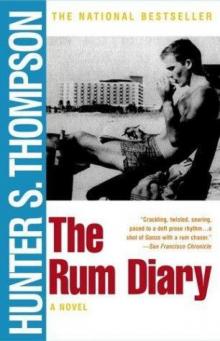 The Rum Diary
The Rum Diary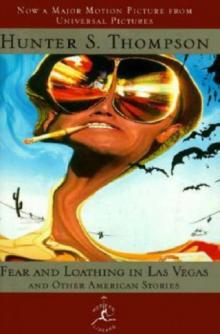 Fear and Loathing in Las Vegas and Other American Stories
Fear and Loathing in Las Vegas and Other American Stories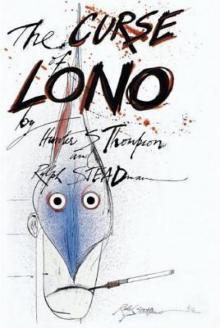 The Curse of Lono
The Curse of Lono Proud Highway: Saga of a Desperate Southern Gentleman, 1955-1967
Proud Highway: Saga of a Desperate Southern Gentleman, 1955-1967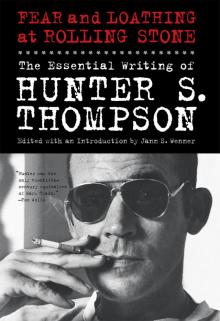 Fear and Loathing at Rolling Stone: The Essential Hunter S. Thompson
Fear and Loathing at Rolling Stone: The Essential Hunter S. Thompson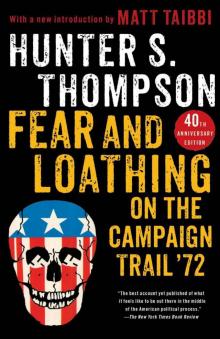 Fear and Loathing on the Campaign Trail '72
Fear and Loathing on the Campaign Trail '72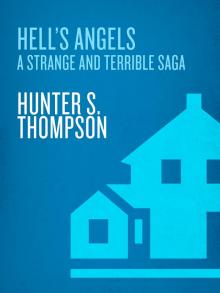 Hell's Angels: A Strange and Terrible Saga
Hell's Angels: A Strange and Terrible Saga The Great Shark Hunt: Strange Tales From a Strange Time
The Great Shark Hunt: Strange Tales From a Strange Time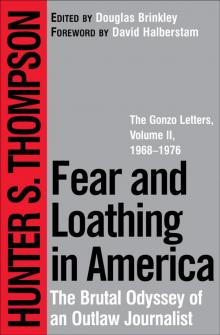 Fear and Loathing in America
Fear and Loathing in America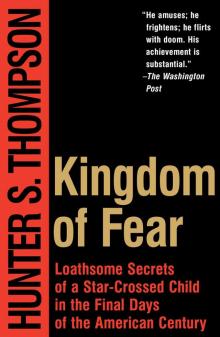 Kingdom of Fear
Kingdom of Fear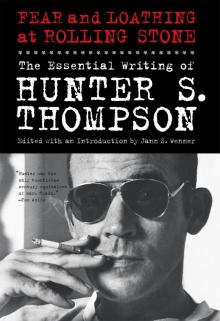 Fear and Loathing at Rolling Stone
Fear and Loathing at Rolling Stone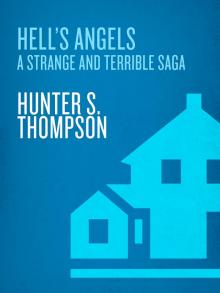 Hell's Angels
Hell's Angels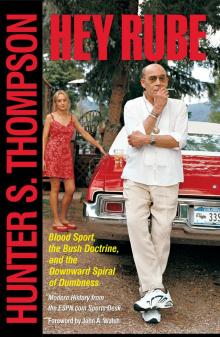 Hey Rube
Hey Rube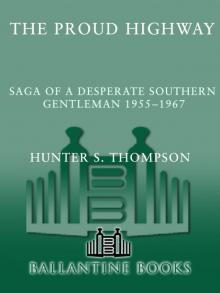 Proud Highway
Proud Highway